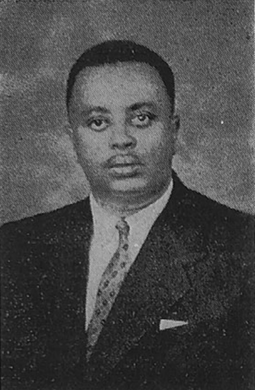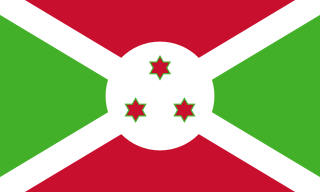Related Research Articles
There are a number of systems of transport in Burundi, including road and water-based infrastructure, the latter of which makes use of Lake Tanganyika. Furthermore, there are also some airports in Burundi.

Bujumbura, formerly Usumbura, is the economic capital, largest city and main port of Burundi. It ships most of the country's chief export, coffee, as well as cotton and tin ore. Bujumbura was formerly the country's political capital. In late December 2018, Burundian president Pierre Nkurunziza announced that he would follow through on a 2007 promise to return Gitega its former political capital status, with Bujumbura remaining as economical capital and center of commerce. A vote in the Parliament of Burundi made the change official on 16 January 2019, with all branches of government expected to move to Gitega within three years.

Prince Louis Rwagasore was a Burundian prince and politician, who was the second prime minister of Burundi for two weeks, from 28 September 1961 until his assassination on 13 October.

Gitega, formerly Kitega, is the political capital of Burundi. Located in the centre of the country, in the Burundian central plateau roughly 62 kilometres (39 mi) east of Bujumbura, the largest city and former political capital, Gitega is the country's fourth largest city and former royal capital of the Kingdom of Burundi until its abolition in 1966. In late December 2018, Burundian president Pierre Nkurunziza announced that he would follow on a 2007 promise to return Gitega its former political capital status, with Bujumbura remaining as economic capital and centre of commerce. A vote in the Parliament of Burundi made the change official on 16 January 2019, with all branches of government expected to move in over three years.

Air Burundi was the state-owned national airline of Burundi, although in practice it has not been operational since 2009.

Burundi, officially the Republic of Burundi, is a landlocked country in the Great Rift Valley at the junction between the African Great Lakes region and Southeast Africa. It is bordered by Rwanda to the north, Tanzania to the east and southeast, and the Democratic Republic of the Congo to the west; Lake Tanganyika lies along its southwestern border. The capital city is Gitega and the largest city is Bujumbura.
Burundi ratified the 2000 UN TIP Protocol in May 2012.

The Bonifacio Transport Corporation, or more commonly known as BGC Bus or formerly The Fort Bus, is an intercity bus company in Metro Manila, the Philippines, serving routes that connect Makati and Bonifacio Global City, Taguig.

Burundi–Kenya relations are bilateral relations between Burundi and Kenya. Burundi is a partner of Kenya in many areas, particularly trade, security (military), education, agriculture and energy. In 2011, both countries signed a comprehensive bilateral agreement to promote development and technology transfer in agriculture, livestock and fisheries development between them.
Burundi–Tanzania relations are bilateral relations between Burundi and Tanzania. Burundi is a strategic partner of Tanzania in many areas, particularly trade. Since Burundi is a landlocked country, almost 80% of its goods are moved through by road to Dar es Salaam Port. Tanzania has also been a strategic partner in mediating the political tensions in the country. Both countries are members of the African Union.
The Bujumbura Central Market was a public market in the center of Bujumbura, Burundi. It burned down in January 2013, and the site was abandoned.
Office National de la Tourbe, or ONATOUR is a publicly owned enterprise that mines peat in Burundi.
The Public Transport Office, or OTRACO is a publicly owned enterprise that inspects vehicles and operates public transport in Burundi.
The Port of Bujumbura is a port on Lake Tanganyika serving the city of Bujumbura, Burundi.
Société Pétroliere du Burundi, or SOPEBU, is a public company that imports, stores and distributes petroleum products in Burundi.
Société de l’Armement Nord des Grands Lacs , is a private company that operates a fleet of cargo boats on Lake Tanganyika. It is based in the Port of Bujumbura in Burundi.
Bateau de transport sur lac, is a private company that operates cargo boats on Lake Tanganyika. It is based in the Port of Bujumbura in Burundi.
Twitezimbere ASBL is a non-profit association serving low income peasant farmers in Burundi. It assists them in adopting good farming and business practices, obtaining micro-credit, finding markets and so on. Challenges include illiteracy, traditional biases about women's roles, potential environmental damage from development projects and rapid population growth. Twitezimbere Microfinance, originating from and associated with Twitezimbere ASDL, is now a public limited microfinance company under the Ministry of Environment, Agriculture and Livestock.
The Imbo Regional Development Company, or SRDI, is a public company that sponsors rural development in the Imbo natural region of northwest Burundi.
The National Pharmaceutical Office, or ONAPHA, was a public company that made pharmaceutical products in Burundi.
References
- ↑ Anyango 1997, p. 6.
- 1 2 Rugamba & Wainaina 1994, p. 27.
- ↑ Burundi alternative energy: Peat ii, p. 24.
- ↑ The Burundian Economy: Current Situaton, pp. 13–14.
- ↑ Decoudras 1984, pp. 223–225.
- 1 2 Minutes of discussion on the bus maintenance.
- 1 2 Mwase 1994, p. 88.
- ↑ Rugamba & Wainaina 1994, p. 26.
- 1 2 Madirisha 2014.
- 1 2 John Veerkamp.
- ↑ Proposed development credit of SDR 64.9, p. 16.
- ↑ Burundi Structural Adjustment and Development, p. 7.
- ↑ WT/TPR/S/113 Trade Policy Review, p. 51.